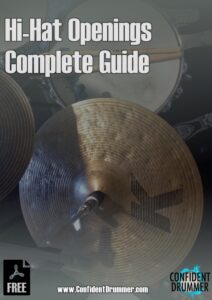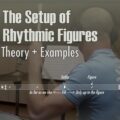When speaking about groove mastery and the tools that can help us achieve that, one of the key components to address is the important topic of Hi-Hat openings.
Practicing these solutions not only allows us to improve our technical coordination but also lets us include the fourth limb, the often forgotten left foot, in very effective and musical ways.
Opening and closing the Hi-Hat is even a key element in being able to create original and personalized beats.
I love the subtle nuances and colors that this kind of solutions can add to what we play, and in my experience the drummers that are truly capable of using them smoothly and convincingly are few.
The reason is to be found in the fact that every time the left foot is involved, a new challenging layer of independence needs to be working effortlessly, and that takes lots of control in order to ensure that this additional element doesn’t destabilize the foundations of our beats.
However, despite the importance of executing Hi-Hat openings with perfect accuracy, the most important detail is the sound we produce with these cymbals, which needs to be balanced and nicely blended with Bass Drum and Snare.
When we open and close the Hi-Hat, we want to make it sound like it’s breathing. It should remind us of lungs contracting and expanding, inhaling and exhaling.
To achieve this effect, the left foot has to be able to carefully adjust the pedal tension and pressure so that the opening and closing between top and bottom cymbals is smooth and pleasing to hear.
Furthermore, for a ‘full’ and musical sound, it’s important to use the shaft of the stick, so that we have more weight and energy at our disposal and we can generate a more effective and dynamically balanced tone.
However, it’s important to try all dynamic levels, as usual, using the guidelines explained in the article ‘Increasing Dynamic Control‘.
One more element that comes into play is the duration of the opening. The sound of the open Hi-Hat should be thought of as a note with a certain value.
Now, that’s something we are not too used to do on the drums, since almost all of the sounds we produce have a really quick attack but they last a very brief time.
In other words we are not used to control both the beginning and the end of a note, like most musicians do.
That’s why we need to pay close attention not only to opening the cymbals in the right spot, but also on closing them exactly where it is meant to be.
Being able to do this requires a high level of independence with the left foot, which needs to be almost ‘unwired’ from the other limbs, so that it can move freely.
One of the most effective ways to develop such a level of autonomy is exactly practicing exercises like the following ones with great attention to detail.
As a matter of fact we are going to come across many cases where both the opening and the closing happen in unusual positions, and not in sync with Bass Drum and Snare Drum, like they typically are. Precisely to attain the level of control we seek.
One further detail to consider is the way we play the intermediate cymbal notes that occur between the opening and the closing.
For instance, if we have and opening that lasts for a quarter note, while we are executing an eighth note beat, there is going to be an in-between note played with the right hand, while the Hi-Hat is open.
Of course we could choose to halt the right hand during the opening, but that would likely compromise the consistency of our groove, which as we know it’s our number one priority.
That’s why most drummers tend to prefer to keep playing, and it’s possible to do that with two different approaches, which have different sounds and applications:
- We can play those intermediate notes very lightly, letting the open sound resonate fully, so that basically the middle notes are not audible (in which case, practically we could not play them, but as we said above we decide to still do it to ensure a consistency of mechanics and movements that is helpful in terms of groove and timing).
- We can play them normally, using the same dynamic level of all other Hi-Hat notes, therefore making each additional note played in the middle of the opening noticeable.
The latter is a less used technique, but it’s worth to experiment with it, for situations where such more aggressive sound fits the song arrangement or musical moment.
So, to sum it up, in studying Hi-Hat openings we need to take care of:
- Accuracy (coordination and independence).
- Sound.
- Duration.
In these studies we are going to find advanced exercises that will enable us to do exactly that.
We are going to practice:
- Downbeat openings and closings.
- Upbeat openings and closings.
- Opening and closing durations between one sixteenth note and two quarters.
- Eighth note, sixteenth note, eighth note triplet and shuffle examples.
Here is the free PDF with all transcriptions:
To get a taste of how each opening sounds it’s important to check out its video demonstration, which can also be accessed by clicking on each example in the booklet.
The 47 exercises included are all based on a simple rhythm with Bass Drum on one and three, and Snare Drum on two and four. We can consider them a useful starting point to focus on the Hi-Hat component.
Later we can experiment with different, gradually more advanced rhythms until we are able to improvise freely any Hi-Hat opening without it destabilizing what we are playing.
Related resources:
Hi-Hat Embellishments – 20 Advanced Grooves
‘Groove Workout & Tools’ – Altitude Drumming – Volume 7
‘Coordination & Independence’ – Altitude Drumming – Volume 4




















